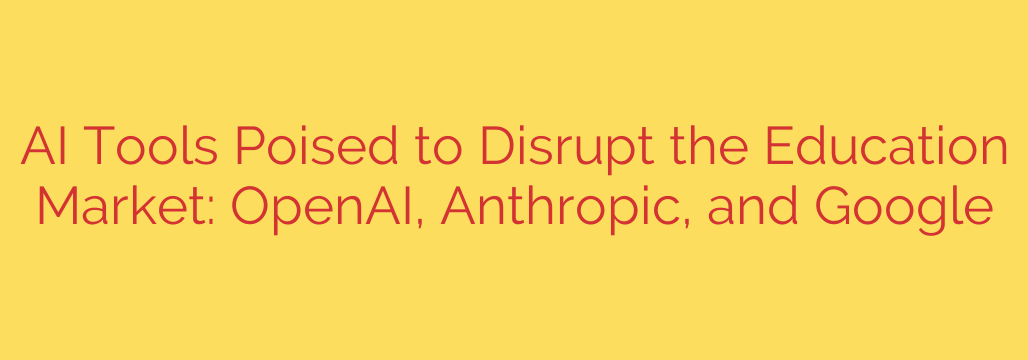
The AI Revolution in Education: How Tech Giants Are Reshaping the Classroom
The landscape of modern education is on the brink of its most significant transformation yet. Artificial intelligence is no longer a futuristic concept discussed in academic papers; it’s an active, powerful force being integrated directly into the tools that students and teachers use every day. Major technology leaders like OpenAI, Google, and Anthropic are in a race to define the future of learning, moving beyond general-purpose AI to create specialized tools designed specifically for the unique needs of educational institutions.
This shift marks a pivotal moment, promising to enhance learning, streamline administrative tasks, and provide personalized support on an unprecedented scale.
OpenAI Sets its Sights on Higher Education with ChatGPT Edu
OpenAI, the company that brought generative AI into the mainstream with ChatGPT, is now making a direct and strategic move into the education sector. Their latest offering, ChatGPT Edu, is a version of their popular AI model specifically tailored for university use. Built on the new and powerful GPT-4o model, it’s designed to serve students, faculty, researchers, and campus operations teams.
What makes ChatGPT Edu different from the consumer version? It offers several key advantages for academic environments:
- Enhanced Capabilities: Access to advanced features like data analysis, web browsing, and document summarization.
- Enterprise-Level Security: Crucially, it comes with robust security and data privacy controls, ensuring that conversations and data are not used to train OpenAI’s models.
- Greater Capacity: Higher message limits allow for more extensive and complex interactions, which is essential for research and detailed coursework.
By addressing the core concerns of data privacy and security, OpenAI is positioning ChatGPT Edu as a responsible and powerful tool for higher education, aiming to become an indispensable partner in academic research and learning.
Google’s Seamless Integration into the Educational Ecosystem
While OpenAI builds new gateways, Google is fortifying its existing empire. With the widespread adoption of Google Workspace for Education and Google Classroom, the tech giant already has a deep-rooted presence in schools worldwide. Its strategy is one of seamless integration.
Instead of a single standalone product, Google is embedding its powerful Gemini AI models directly into the tools teachers and students already use daily. Imagine:
- Lesson Planning Assistance: Generating creative ideas and outlines for lessons directly within Google Docs.
- Streamlined Communication: Drafting emails and announcements to parents and students in Gmail.
- Data Insights: Creating presentations that summarize research findings from data in Google Sheets.
Google’s primary advantage is its ecosystem. By weaving AI capabilities into established workflows, the company is making AI adoption feel less like a disruption and more like a natural evolution, significantly lowering the barrier to entry for educators who are already familiar with its platforms.
The Rise of Safety-Focused AI in the Classroom
As schools weigh the benefits of AI against potential risks like misinformation and bias, companies that prioritize safety are gaining significant attention. This is where competitors like Anthropic, known for their focus on AI ethics and safety, come into play.
Anthropic’s approach, centered on principles like “Constitutional AI,” is designed to create models that are more reliable, predictable, and less likely to generate harmful or inappropriate content. For school districts and universities, this focus on safety is a massive selling point. An AI tool that can be trusted in a student-facing environment is critical for responsible implementation. While they may not have the market penetration of Google, their emphasis on ethical AI makes them a compelling choice for institutions where student safety and digital citizenship are top priorities.
Navigating the AI Transition: What Educators Need to Know
The integration of AI into education is not a question of if, but how. This new generation of tools offers the potential to act as a powerful teaching assistant, freeing up educators from repetitive tasks to focus on mentorship, critical thinking, and personalized student support. However, this transition requires careful planning and consideration.
Here are some actionable steps for educators and administrators:
Prioritize Data Privacy: Before adopting any AI tool, thoroughly vet its data privacy policy. Understand what data is collected, how it is used, and whether it is protected under regulations like FERPA. Opt for platforms, like ChatGPT Edu, that explicitly state they will not train their models on your institution’s data.
Foster Digital Literacy and Critical Thinking: Teach students to view AI as a co-pilot, not an infallible expert. It’s essential to equip them with the skills to question AI-generated content, identify potential biases, and verify information from primary sources.
Invest in Professional Development: For AI to be effective, teachers must be comfortable and competent in using it. Schools should provide ongoing training that focuses not just on the technical aspects, but also on pedagogical strategies for integrating AI into the curriculum.
Start with Pilot Programs: Instead of a campus-wide rollout, consider starting with smaller pilot programs. This allows institutions to gather feedback, identify potential challenges, and develop best practices in a controlled environment before a larger-scale implementation.
The future of education will be a partnership between human educators and artificial intelligence. By embracing these tools thoughtfully and strategically, we can unlock a new era of personalized, efficient, and more engaging learning for everyone.
Source: https://www.bleepingcomputer.com/news/artificial-intelligence/openai-anthropic-google-may-disrupt-education-market-with-new-ai-tools/








